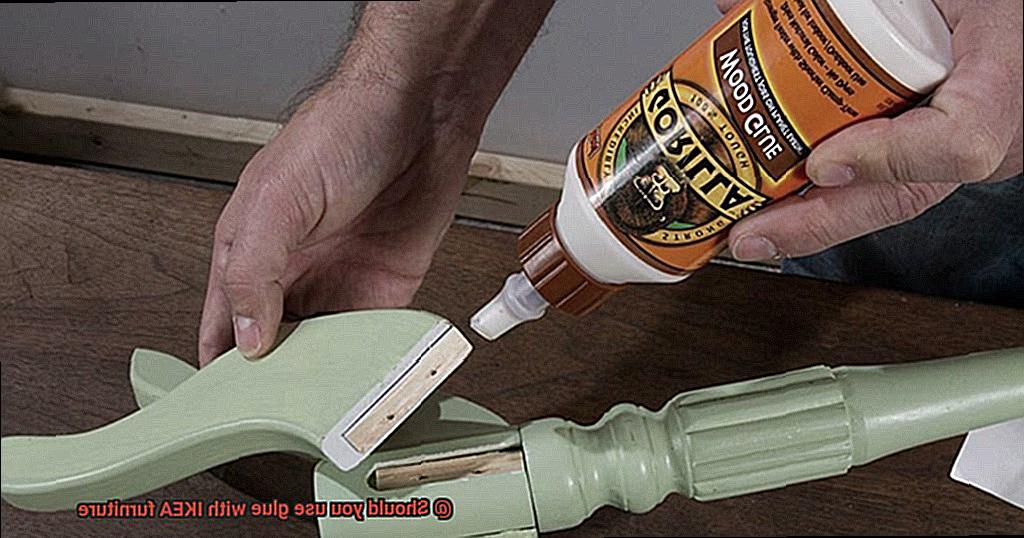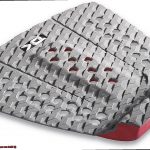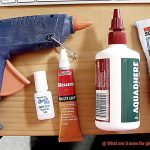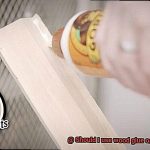The holy grail of affordable home decor, with its sleek lines and modern charm. But let’s be real, assembling that stuff can be a real headache. And then comes the age-old question: should you bust out the glue or leave it untouched? It’s like choosing between a trusty sidekick or an annoying little sibling.
In this blog post, we’ll dive into the nitty-gritty of using glue with your beloved IKEA furniture. We’ll weigh the pros and cons, from sturdiness to flexibility, and even consider your wallet’s feelings.
By the end, you’ll have all the deets to decide if glue is your ride-or-die companion or just an unnecessary hassle in your quest for Swedish-inspired bliss.
What Is Glue and What Does It Do?
Contents
- 1 What Is Glue and What Does It Do?
- 2 When Is Glue Necessary for IKEA Furniture?
- 3 What Type of Glue Should Be Used With IKEA Furniture?
- 4 How to Properly Apply Glue to IKEA Furniture
- 5 Advantages of Using Glue With IKEA Furniture
- 6 Disadvantages of Using Glue With IKEA Furniture
- 7 Factors to Consider Before Deciding Whether or Not to Use Glue
- 8 Conclusion
Glue is an incredibly fascinating substance that serves a vital role in our daily lives. Whether you’re constructing furniture, repairing broken items, or engaging in arts and crafts projects, glue is the reliable adhesive that helps us achieve sturdy and enduring bonds.
At its core, glue is a sticky substance designed to bond materials together. It comes in various forms, such as liquid, gel, or solid, and is composed of a combination of polymers, solvents, and additives. These ingredients provide glue with its adhesive properties, allowing it to create robust connections between surfaces.
The primary function of glue is to create strong bonds between materials. When applied to a surface, glue infiltrates the tiny crevices and forms a molecular bond with the material. This bond ensures that the materials stay securely attached and can withstand forces such as pulling or twisting.
Glue works through a chemical reaction called polymerization. This process transforms the liquid or gel-like glue into a solid state, creating a durable adhesive bond. The exact mechanism of polymerization varies depending on the type of glue being used.
There are different types of glue available, each specifically formulated for particular purposes and materials. For example, wood glue is designed to bond wooden surfaces together, while super glue is renowned for its fast-drying and strong bonding properties. Specialized glues also exist for fabrics, metals, plastics, and ceramics.
In addition to bonding materials together, glue has other versatile uses as well. It can be used as a sealant to fill gaps or cracks in surfaces, preventing the entry of air or moisture. Glue can also be employed for decorative purposes, such as attaching embellishments or creating beautiful collages.
When it comes to assembling furniture, many people ponder whether they should use glue, particularly with popular brands like IKEA. While glue can provide additional strength and stability to the furniture, it is not necessary for all pieces. Some items are designed to be assembled without the need for glue, relying solely on the provided hardware.
If you do choose to use glue with IKEA furniture or any other type of assembly, it is crucial to follow the manufacturer’s instructions. These instructions will indicate whether glue is recommended or necessary for a specific piece of furniture. It is also advisable to use the specific type of glue recommended by the manufacturer to ensure compatibility with the materials used.
While using glue can be advantageous, it may also make disassembly or reassembly more challenging in the future. If you anticipate needing to frequently move or disassemble your furniture, it may be best to avoid using glue altogether.
When Is Glue Necessary for IKEA Furniture?
Let’s start with the basics: most IKEA furniture is designed to be assembled without glue. That’s right, folks, no sticky situations required. But, there are times when a little bit of glue can work wonders, giving your furniture that extra dose of stability and endurance.
Imagine you’re a wanderlust soul, always on the move. In this case, adding a dollop of glue to the joints can prevent them from loosening over time. Say goodbye to wobbly tables and chairs haunting your dreams.
Or perhaps you have a tribe of lively kids or energetic pets who love to put your furniture through the wringer. Glue can be your secret weapon in reinforcing those high-stress areas like corners and edges, ensuring your furniture can withstand the chaos.
Before you dash to the store for glue, let’s go over some crucial tips. First and foremost, choose a robust adhesive that’s compatible with your furniture’s materials. IKEA has got your back with recommendations in their assembly instructions.
Now, cleanliness is key. Before applying any glue, make sure those surfaces are squeaky clean and bone dry. Trust us, a solid bond needs a pristine foundation.
Still unsure if glue is necessary for your specific piece of IKEA furniture? Don’t fret. Take a peek at the assembly instructions or reach out to IKEA’s customer service for expert guidance tailored to your needs.
What Type of Glue Should Be Used With IKEA Furniture?
IKEA furniture is renowned for its affordability, durability, and easy assembly. While glue is not always necessary for assembling IKEA furniture, there are situations where adding a little adhesive can provide extra stability and peace of mind.
In this comprehensive guide, we will explore the best type of glue to use with IKEA furniture. We’ll consider the material of the furniture, compare various glue options, discuss their benefits and drawbacks, and offer tips for successful gluing.
Material Matters:
Most IKEA furniture is crafted from particleboard or medium-density fiberboard (MDF), which can be trickier to bond than solid wood. It’s crucial to choose a glue that is compatible with these engineered wood products.
Carpenter’s Glue (Wood Glue):
Carpenter’s glue, specifically designed for woodworking projects, is a popular choice for gluing IKEA furniture. It delivers a robust bond. Opt for high-quality carpenter’s glue suitable for indoor use that dries clear.
Polyurethane Glue (PU Glue):
Polyurethane glue creates a strong bond and expands as it cures, effectively filling gaps in joints. It is ideal for reinforcing wobbly areas or those under stress. However, it requires careful application to prevent excess glue seepage.
Epoxy Glue:
Epoxy glue consists of two parts that must be mixed before application. It provides a sturdy bond and resists moisture, making it suitable for areas prone to spills or humidity. Keep in mind that epoxy glue can be pricier than other options.

Tips for Successful Gluing:
- Carefully read and follow the manufacturer’s instructions.
- Clean and prepare the surfaces before applying the glue.
- Test the glue on a small, inconspicuous area of the furniture first.
- Use clamps or weights to hold glued parts together during curing.
- Allow sufficient drying time before using or moving the furniture.
Disassembly Considerations:
While glue can enhance the stability of IKEA furniture, it may complicate future disassembly. If you anticipate needing to disassemble and reassemble the furniture multiple times, relying solely on the provided hardware without glue might be a better option.
How to Properly Apply Glue to IKEA Furniture
Glue is the secret ingredient that can make your furniture sturdy and long-lasting. But before you grab that glue bottle, let’s explore the proper techniques for applying glue to IKEA furniture. Get ready to become a glue expert.
Cleanliness is Crucial:
Before you embark on your gluing adventure, ensure that the surfaces to be glued are squeaky clean. Wipe away any dust or dirt using a damp cloth or mild detergent. By starting with clean surfaces, you’re laying the foundation for a rock-solid bond.
Choose the Perfect Potion:
Not all glues are created equal, my friends. Look for a robust wood glue or one specially formulated for furniture assembly. Take the time to read the instructions carefully and find the best glue for your project. Don’t forget to check if IKEA recommends a specific type of glue for their furniture too.
Fit it Like a Puzzle:
Hold your horses. Before you start gluing, do a dry fit of the pieces. Make sure they fit together like puzzle pieces before applying any glue. This way, you can make any necessary adjustments and ensure flawless assembly.
Apply with Finesse:
Now comes the fun part – applying the glue. Use a brush or small applicator to apply a thin and even layer of glue to one of the surfaces. Remember, less is more. Resist the temptation to go overboard with the glue; too much can create a messy situation and weaken the bond.
Press and Hold, Let Magic Unfold:
Once you’ve applied the glue, press the pieces together firmly. Hold them in place for a few minutes to let the magic happen. To ensure everything stays in place, you can use clamps or heavy objects while the glue sets. This step is crucial for achieving a strong and durable bond.
Wipe Away the Excess:
Uh-oh, did some glue sneak out? No worries. Before it dries completely, swiftly clean up any excess glue with a damp cloth. By doing this, you’ll keep your furniture looking fabulous and glue-free.
Advantages of Using Glue With IKEA Furniture
You’re probably familiar with the excitement of bringing home a new piece and the anticipation of assembling it. But did you know that there’s a secret ingredient that can take your IKEA furniture to the next level of stability and durability? That’s right – glue.
Using glue when assembling your IKEA furniture has several advantages that can enhance your overall experience and ensure that your furniture lasts for years to come. Let’s dive into the benefits of using glue:
- Stability and Durability: Applying glue to the joints and connections of your furniture adds an extra layer of stability and strength. This is especially important for items that may be subject to heavy use or weight, such as dining tables or bookshelves. By reinforcing the structure with glue, you can prevent wobbling or loosening over time.
- Noise Reduction: We’ve all experienced the annoyance of a squeaky chair or a creaky table. By using glue, you can eliminate these noises by reducing friction between the different parts. This is particularly beneficial for items that require constant movement, like office chairs or kitchen stools.
- Aesthetic Appeal: Glue can also help create a seamless and polished look for your furniture. By filling in any gaps or spaces between joints, it creates a tighter fit and prevents dust or debris from accumulating in those hard-to-reach areas. This not only enhances the overall appearance but also makes cleaning easier.
- Easy Assembly and Disassembly: Contrary to popular belief, using glue doesn’t mean permanent attachment. By using a removable or non-permanent adhesive, you can still enjoy the benefits mentioned above without compromising the ability to disassemble your furniture if needed. The added benefit is that it holds the parts together securely during assembly, reducing the risk of losing small screws or fittings.
- Peace of Mind: When using glue with your IKEA furniture, you can have peace of mind, knowing that your furniture is more secure and less likely to break or come apart. This is particularly important for families with young children who may be more prone to climbing or putting extra strain on the furniture.
Furthermore, using glue with IKEA furniture is not necessary for every piece. It is important to carefully consider the specific item and its intended use before deciding whether or not to use glue. For example, smaller items like side tables or decorative shelves may not require the added stability that glue provides.
Disadvantages of Using Glue With IKEA Furniture
When it comes to assembling IKEA furniture, the question of whether or not to use glue often arises. While it may seem like a good idea at first, there are several disadvantages to consider before reaching for that tube of adhesive. In this article, we’ll explore why using glue with your IKEA furniture may not be the best choice.
Difficulty in Disassembly and Moving:
One of the primary advantages of IKEA furniture is its easy disassembly and portability. Applying glue to the joints and connections can turn this convenient feature into a nightmare. Disassembling glued furniture becomes a challenging task, often resulting in potential damage or the need for expensive professional assistance during moves or transport.
Voiding the Warranty:
IKEA typically offers warranties on their products, but using glue during assembly might void this warranty. This means that if any issues arise with the furniture, such as defects or damage, IKEA will not be responsible for repairs or replacements. It is crucial to understand the terms and conditions of the warranty before deciding to use glue.
Potential Damage to Materials:
Certain materials used in IKEA furniture, like veneer or laminate, may react poorly to certain types of glue. The harsh chemicals or solvents in the glue can cause discoloration, warping, or even deterioration of these materials over time. It is essential to choose a suitable adhesive compatible with the specific materials used in the furniture to avoid any potential damage.
Limited Customization Options:
Part of IKEA’s appeal is its versatility and ability to be personalized according to individual preferences. However, using glue during assembly limits future modifications or customization. The permanent nature of glue makes it difficult or even impossible to change the color or add additional components, restricting creativity and flexibility.
Questionable Structural Improvements:
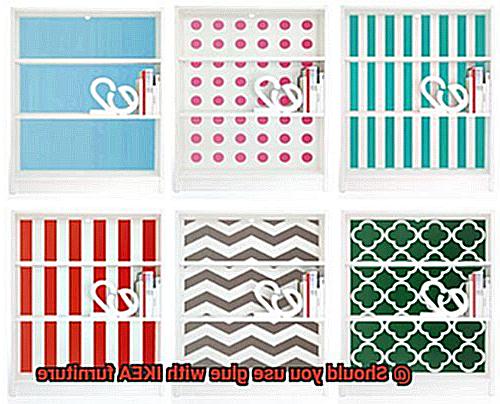
Some people may use glue to reinforce the joints and connections of their IKEA furniture, hoping for improved structural integrity. However, most IKEA furniture is already designed to be sturdy and durable without the need for additional adhesives. Relying on glue can create a false sense of security, leading individuals to neglect proper assembly according to provided instructions.
Factors to Consider Before Deciding Whether or Not to Use Glue
When faced with the decision of whether or not to use glue, it is important to consider a variety of factors. From the level of assembly difficulty and intended use, to portability, warranty concerns, skill and experience, and safety considerations, each factor plays a crucial role in determining the necessity of glue.
In this article, we will explore these factors in detail, enabling you to make an informed decision that meets your specific needs.
Assembly Difficulty:
Consider the complexity of the furniture and determine if glue is necessary for stability and durability. While most furniture is designed to be easily assembled without glue, certain intricate pieces may require it.
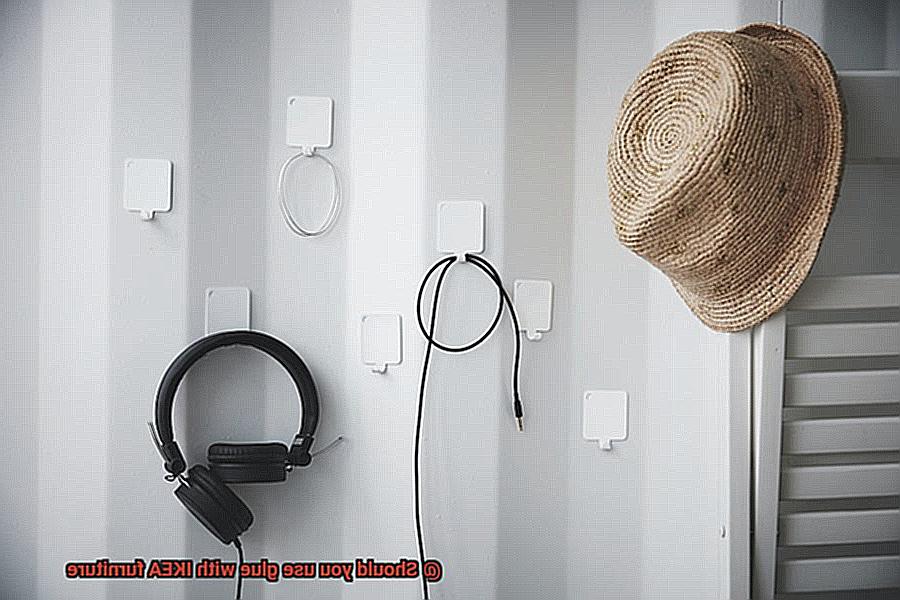
Intended Use:
Evaluate whether the furniture is for short-term or long-term use. If it’s for a rental property or dorm room, glue may not be essential. However, for long-term use in high-traffic areas, adding glue can provide extra reinforcement and prevent joint loosening over time.
Portability:
Think about how frequently you move or rearrange furniture. Gluing your furniture can make disassembly and reassembly more challenging. Unless it’s absolutely necessary, skipping the glue may be more practical.
Warranty and Resale Value:
Review the manufacturer’s warranty as gluing furniture may void it. Furthermore, using glue may limit resale value as some buyers prefer easily disassembled pieces.
Skill and Experience:
Assess your own abilities with assembling furniture. If you are experienced and have successfully built furniture without glue before, there may be no need to deviate from that approach. However, for novices or those lacking confidence in their skills, glue can provide added security and peace of mind.
Safety Considerations:
Consider the safety risks associated with certain glues that emit strong fumes during the drying process. Ensure proper ventilation and follow manufacturer instructions for safe application.
uwnICDeEe7s” >
Conclusion
In conclusion, the decision of whether or not to use glue with your IKEA furniture is a matter of careful consideration. Adding glue can offer extra strength and longevity to your furniture, but it’s important to be aware that it may complicate disassembly and potentially void the manufacturer’s warranty. So, think twice before reaching for that bottle of adhesive.
If you do decide to go ahead with gluing, ensure you choose a type that is compatible with the materials used in your furniture. Follow the manufacturer’s instructions diligently, applying the glue properly and ensuring clean, dry surfaces for optimal bonding. Don’t forget to use clamps or weights to hold everything together while the glue cures, and swiftly wipe away any excess before it sets.
However, if you foresee a need to frequently move or disassemble your furniture, it might be wise to steer clear of glue altogether. IKEA furniture is designed to be assembled without any adhesive and can still provide ample stability and durability when correctly put together according to the provided instructions.
Ultimately, the choice of whether or not to use glue with your IKEA furniture rests in your hands. Take into account your specific needs and preferences, as well as how you plan on using the furniture.

